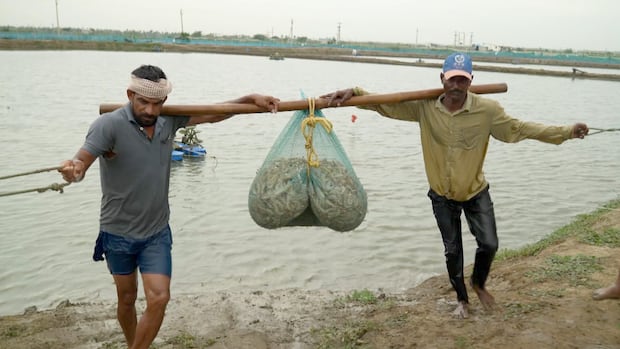‘So much pain’: India’s shrimp farmers underpin US tariffs

The dozen men joked and whistled as they waded through the water of a shrimp pond in India’s southeastern coastal state of Andhra Pradesh, pulling a large net behind them as they tried to catch as many shrimp as possible.
The light-hearted atmosphere masked deep concern over the 50% tariffs the United States slapped on Indian exports in August that heavily damaged India’s frozen shrimp industry.
“Everyone is desperate,” said Bhaskar Kokkiligadda, one of the daily workers who rotates to different shrimp farms in the area near Pedapatnam, Andhra Pradesh, which lies surrounded by the Godavari River that rushes into the nearby Bay of Bengal.
Before the tariffs were implemented, the United States was India’s largest customer for shrimp exports, taking just over 40% of the market. This totaled more than US$2.5 billion (CDN$3.5 billion) in sales in the 2023-24 financial year, according to India’s Ministry of Commerce and Industry.
Now that shrimp are harvested more sporadically and much of what is transported is put on ice and in storage containers, shipments to the United States have mostly stopped.
Kokkiligadda said some of the workers who relied on the shrimp harvest volunteered to take pay cuts and others were showing up for jobs even though they knew they didn’t need to in the hope they could make a few extra rupees.

“Before we had 20 days of work (a month). Now it’s only 10 days,” he said. “I don’t know how I handle it.”
India’s shrimp industry is responsible for more than a million jobs in export companies, shrimp processing plants and hundreds of small-scale farms.
The pain is particularly acute in Andhra Pradesh, where 75 to 85 percent of India’s shrimp is produced, much of which went directly to shipping containers destined for the United States, according to industry data.
Prices have doubled
The initial tariff on Indian exports was set at 25%, but was later doubled to 50% by US President Donald Trump as punishment for Indian purchases of Russian crude oil.
This has given a competitive advantage to India’s main international rival for shrimp exports, Ecuador, which faces a 15% tariff.
“We were already suffering from (25% service),” said Praveen Sabbineni, who employs several hundred workers on three farms in Andhra Pradesh.
He said the price he gets for his shrimp is down nearly 40 percent and that’s forcing many farmers to seriously consider ditching shrimp altogether. Others are working to develop other export markets, but that process could take months.
“We feel so much pain.”

‘Very difficult times’
It’s worse for the vast majority of Indian shrimp farmers who have tiny plots of land.
“These are very difficult times,” Edukal Basani, a shrimp farmer who owns a pond that sits on 0.4 hectares of land, told CBC News.

He recently harvested 200 kilograms of shrimp, but he couldn’t find anyone to sell it to, with the high U.S. tariff in place.
“It was wasted,” said Basani, 45. “It was very depressing. I didn’t want to throw it away.”
The United States was India’s largest export market for shrimp, but 50% export tariffs brought by the Trump administration severely hurt the industry. Some farmers have faced price drops of almost 40% on their catch, and the livelihoods of exporters and workers are at stake.
Even with the state government offering electricity subsidy to shrimp farmers in a bid to offset the sting of the new tariffs, Basani is struggling to make ends meet.
“I have loans to pay back, and I can’t afford my electricity bills.”
Basani, who said he was toying with the idea of leaving shrimping, had to pull his son out of college because he can’t afford the tuition and needed more help on the farm.
Some other job options
Many of the jobs that depend on a robust shrimp industry in India are in more than 300 processing plants, where it is mostly women who spend hours peeling and peeling shrimp.
It is often the most reliable work available to women with few other options, although the industry has been plagued by reports from rights groups of workers being poorly paid, exploited and forced to work overtime.

“My life depends on these salaries,” said Lalitha Rajeshwari, 45, who says she has an alcoholic husband who does not give her money for household expenses.
She and the other women earn between $6 and $9 CDN per day.

Looking for a trade deal
Indian officials are eager to strike a trade deal with the United States to help offset the tariffs, but there are several key sticking points.
Trump has bungled India’s “obnoxious” protectionist trade barriers, but New Delhi insists he will not relent on its red lines or open up its agriculture or dairy sectors. Talks recently restarted after being interrupted for a few weeks in late August.

“We’re all worried” about the effect of the tariffs, Radhika Enti, 24, told CBC News.
She said her family was conservative and would let her work in the factory, which is close to her home and hires only women to process the catch.
“If this unit stops, how can we survive? Who will take care of our children?” The young mother said, without stopping her work peeling shrimp after shrimp.
“There’s nothing else we can do.”
https://i.cbc.ca/1.7652470.1759776859!/fileImage/httpImage/image.jpg_gen/derivatives/16x9_1180/shrimp-farmers.jpg?im=Resize%3D620






